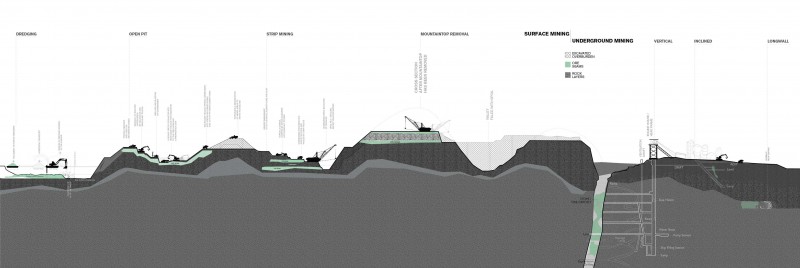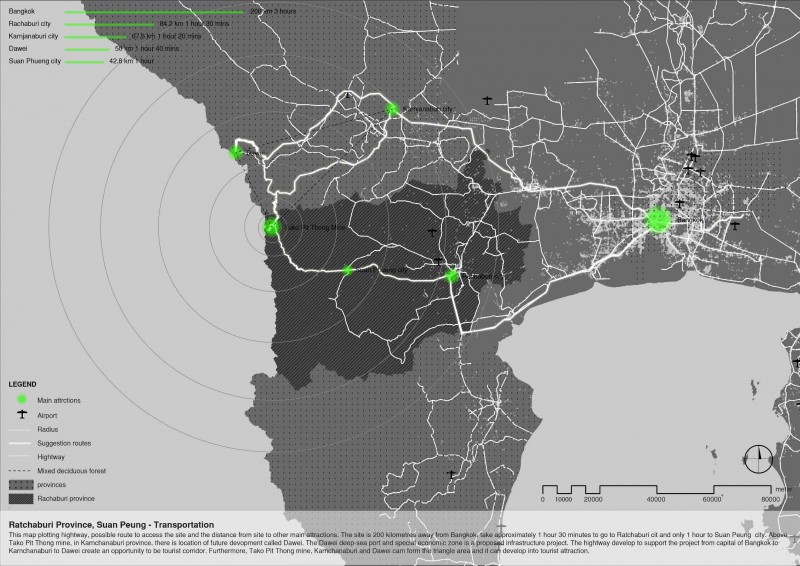UNEARTH: Building on an Excavation
This studio is about mining. Historically, culturally, and ecologically, mining is considered one of most brutal endeavours man has ever pursued. The inhospitable environments – the harsh surrounds of rocks, the subterranean darkness, the agitated ground – in addition to the life-threatening exposure to toxic chemicals and explosive machineries make mining one of the most degrading occupations man can have, even to this day.
Mines and quarries are manufactured landscapes whose formations are direct results of the technological processes used for extraction of resources from the ground. In surface mining, explosives are placed strategically along the mineral veins – where maximum amount of mineral ores could be extracted. Dimensions of cut terraces in stone quarries are determined by the size of machineries used for extraction and transportation of dimension stone.1 The scale of mining pits and stone quarries are some of the largest and most extreme manmade landscapes that unfortunately, in most cases, provide no ecological or environmental benefits. Instead, after the industries move out, these mining sites are like contaminated scars and dead skin on the earth’s surface that take years for rehabilitation before the land could be habitable by flora and fauna again.
But we need mining. As long as humans continue to build and consume, we will always rely on the earth’s resources. The foundation of our capital economy depends on our ability to produce and trade, starting with natural resources as means of establishing value currency. And therefore, the command of natural resources – coal, oil, minerals – equates directly to the power of controlling the global economy. What is the ultimate capitalistic dream if not to strike gold?
The irony is that, even though most of us are well aware of the environmental hazards mining brings, many communities still welcome the industry into their towns. From a socioeconomic perspective, mining boosts the economy, increases job options, and creates investment opportunities. This is all possible, as long as the resources don’t run out.
In this studio, we focus on mining as a tectonic process and mines as manufactured landscapes latent with opportunities for productive interventions in addition to resource extraction. We inquire into the role that architecture can play in this process of earthly operations. Can we remove the stigma of mining by creating a place that is more critical of the surrounding communities and ecology? We collaborate with engineers, landscape architects and geologists in order to maximise our knowledge and resources, and to expand our scope of inquiry to include, not only the immediate context of the site, but also the larger ecological and urbanistic networks around the area.
Tako Pit Thong Mine
Our site is situated in Ratchaburi province. Tako Pit Thong mine sits on a mineral belt that covers an area of 3.4 km2 along the western border between Thailand and Myanmar. It was one of the major suppliers of tin in Thailand since 1971, up until 1985 when the Asian market was taken over by other larger suppliers from China and Indonesia. After that, the mine continued to operate as a feldspar and quartz mine and was eventually decommissioned in 1991. Today, Tako Pit Thong is still rich with minerals. The old factory along with the mining machinery remain intact. Previous mine pits have now become ponds. The government issued a plan to recommission the mine as well as to turn the site into an eco-tourist/ educational destination for learning about mineral resources as well as mining processes. Conveniently, Tako Pit Thong is located only 30 km. from Suan Phueng, one of the popular tourist towns of western Thailand. With plans to construct a deep sea port in Dawei, Myanmar, the site will also fall on the major trade route connecting Dawei to Bangkok, making this a prime opportunity to reinvigorate Rachaburi’s mining industries as well as to attract more people to the area.
INDA Fourth Year Option Studio, 2014

